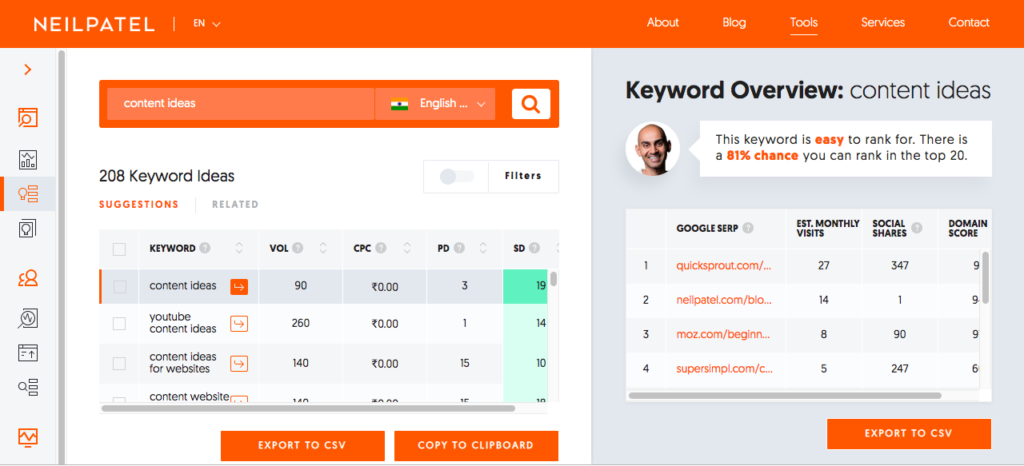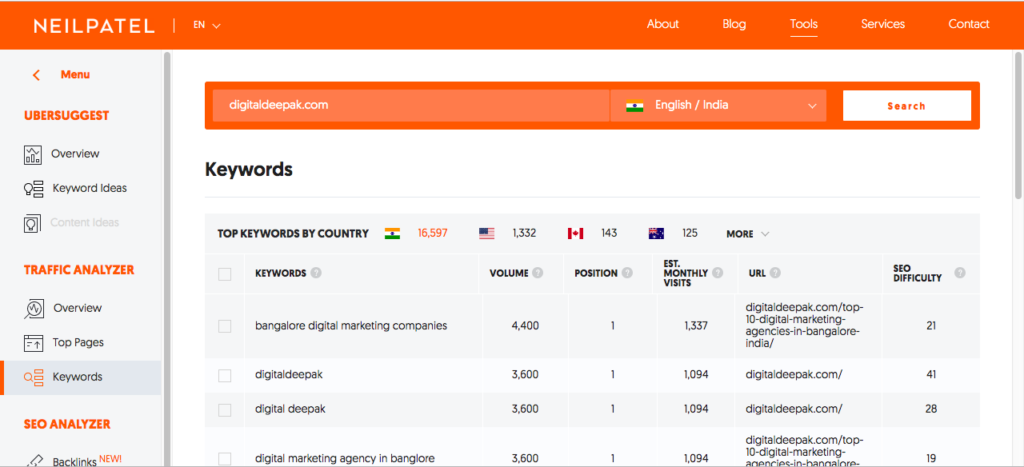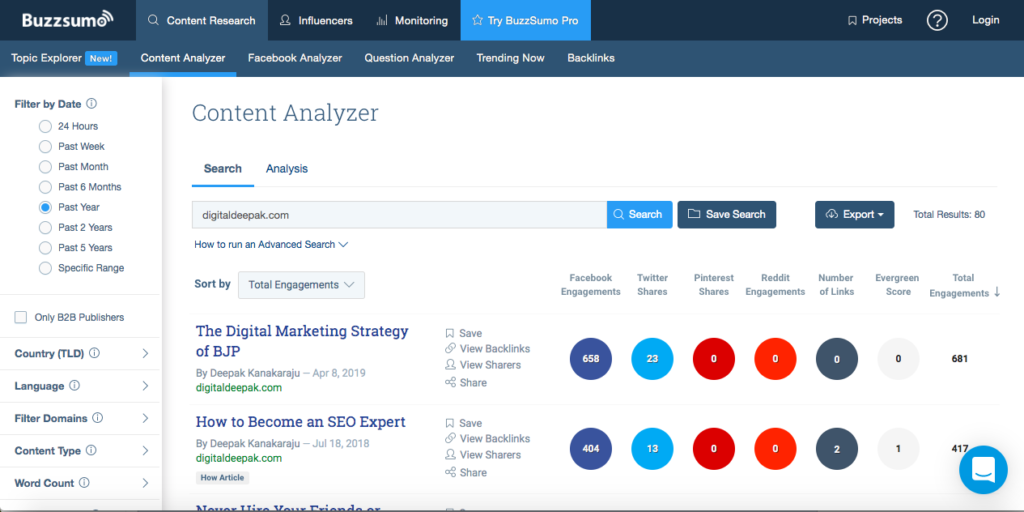There is a weird sense of mysticism around coming up with content ideas, be it for your blog or for your YouTube channel.
I feel people think that you need to go into a deep sense of trance to activate your creative muscles which will then generate unlimited content ideas for them.
They assume, most content creators, have this special ability to create masterpieces every time they sit down and think.
Well, I wouldn’t lie, there are people like that.
But you don’t have to be.
You should stop limiting yourself with the assumption that only certain people are worthy of this skill.
You don’t have to be an artist, but you can still be a creator.
What’s the difference though?
When it comes to marketing, you need to understand that there is both art and craft to it.
The art is where you create content irrespective of the audience hoping that they will be able to match your perceptions and opinions about things.
The craft of it is that you tweak that creative just a little bit for a higher CTR, optimize the article for more traffic, change the colours and positioning of the buttons for better conversions etc.
You might observe that both these things are counterproductive. They negate each other.
But both are equally important.
You have to find that balance between art and craft to produce the most amazing content the world has seen.
Unfortunately, like every art form, even this requires time, patience and most importantly lots and lots of life experiences.
Fortunately, the craft of marketing can definitely be learnt in a shorter time.
So regardless of whether you are a beginner, a business, a blogger, a YouTuber, an Instagram fashionista, or that fitness influencer, you can strategically come up with content ideas that are functional and practically useful for your audience.
But where do you start?
If I were you, I would start with…
Step 1: Understanding Your Audience.

You can pick any marketing activity and this would probably be the first step.
Same goes with coming up with content ideas.
The moment you understand your audience, you will understand what their awareness levels are about your topic and how you can help them.
A lot of times, your audience doesn’t know what they don’t know.
You read that right.
But it’s important that you understand that about them.
Just imagine, if you were to explain digital marketing to a 5-year-old, your mother and a businessman, would you explain the same way to all of them?
That’s what I thought.
It almost seems natural that you change the way you explain in real time depending on who is sitting across the table.
But you would also agree, that if I give you some time you would prepare your pitch to all these guys in the most efficient way.
And that’s exactly what you should be doing before you generate content ideas.
Understand who you are talking to and get in their shoes.
And the easiest way to do this is with user personas. In my previous article, I have extensively written about user personas and how they can be used.
The most powerful tool you can use to come up with content ideas is empathy.
Step 2: Understanding your Audience’s Problems, Motivations, Concerns and Challenges.

Now that you know who you are talking to, understanding their problems, puts you at a great advantage.
If I were to simplify content strategy I would define it is as the way to produce content that aligns with your audience’s problems, motivation, concerns and challenges.
And when you do that, a value transaction happens between you and your audience.
When you do this without any expectation from your audience, they develop a great deal of trust in you.
In essence, it’s not enough to know that your audience is businessmen, you have to dive into what challenges they are facing, what motivates them to overcome their challenges, and what is concerning them about it.
So instead of taking an egocentric approach to content marketing ( which 90% of them do ), taking a problem-solution route will solve your problem of coming up with ideas.
What you are reading right now is the greatest example of this.
I know, who you are as a content creator and what problems you might be facing. I figured that there are different kinds of content creators.
This made me think of a way to generalise the approach in such a way that this process can be used by anyone to create content.
I really hope I am doing a good job at it and I definitely hope I have driven home the point I am trying to make.
Having said that, if you have made this far, you probably would have already figured out a bunch of content ideas.
Step 3: Keyword Research
At this point, once you have listed down the problems and motivations of your users you might have at least a vague idea about the topics that they might be interested in.
Or you can find a middle ground between your offering and the audience, an overlap of their interests and your offering.
If you find this difficult you can put in your topics in answer the public and get a bunch of questions that people might have in mind.
Now shortlist all the questions that might be valid,( answerthepublic gives a lot of suggestions )
Put all of the shortlisted ones in Ubersuggest.

Ubersuggest will then give you these following metrics :
- Search Volume
- CPC
- Paid Difficulty
- Search Difficulty
Once you have these metrics for all the keywords that wanted what you need to look for is:
Keywords with good search volume. As a rule of thumb you can assume that only 25% of your search volume are going to visit your site.
So if the search volume is 100 per month then you might get only about 25 visits per month. Is 25 visits worth it for you? You be the judge.
Now the next thing you need to look for is the CPC ( Cost per click ) and PD ( Paid Difficulty )
You need to look for keywords with a relatively HIGH CPC and PD. But why?
The fact that the CPC and PD is high signifies that the commercial intent behind those keywords is high.
In simple words, the chances of those visitors turning into customers is much more likely.
And these advertisers are bidding for it ( CPC ) and competing fiercely ( PD ) because those keywords are working for them.
And if it’s working for them, it very well might work for them.
Of course, it goes without saying that you also need to be looking for keywords with low Search Difficulty ( SD ) which will mean that it will be easier for you to rank for those keywords relatively faster.
So TL;DR you need to look for keywords that have HIGH Search Volume, HIGH CPC, HIGH Paid Difficulty and LOW Search Difficulty
Step 4: Benchmarking
By now, you already should have a healthy list of keywords with you.
While you were researching for these keywords you might have come across a bunch of websites already ranking for those keywords
Make a list of these websites ( you can shortlist probably 10 of them ) and put them in Uber suggest again. It will show you all the top pages and keywords that the website is ranking for.

Pick out all the keywords that you think is related to your audience and your offering and go through step 3 again ( just to be sure )
After this step, you should have enough keywords and content ideas to write for an entire year.
Also, you can put these websites in Buzzsumo and get content ideas which are viral material.

The idea is simple, try to understand what has worked for your competitors and just reverse engineer the same for your own blog.
Step 5: Validation
Pick your battles wisely.
This can’t be farther than the truth about content ideation and research. It’s super important that you choose topics and keywords that allow you to get the maximum impact with the least risk and effort.
Assuming that the effort you put into content creation is the same, you should obviously be choosing topics that will not only give you the most traffic but also give you the most conversions.
I use this simple formula to validate each of these topics and keywords clusters.
SV X 0.25 X LC X SC = ?
Where,
SV = Search Volume
0.25 = 25% which is the average click-through rate for #1 position
LC = Lead conversion rate
SC = Sales Conversion rate
So for example, let’s say your keyword cluster has a total monthly search volume of 4400 and you are converting traffic to leads at 5% and converting leads to sales at 2%. Then,
4400 X 0.25 X 0.05 X 0.02 = 11 sales which is not bad at all
Now, you need to understand that these numbers might differ for you so calculate accordingly. You might also not have the numbers yet and if that’s the case you can just go ahead and take 5% and 2% as base conversion numbers ( they are industry standards )
I know your next question might be, so what is a good number?
A better question would be, whats a better number?
Amongst all the topics & keywords you have, which ones are giving you the best numbers? And what is the search difficulty like?
Choose topic clusters which have relatively high search volume and relative low search difficulty.
That would be your sweet spot. Go ahead and create content around it!
Step 6: Crowdsourcing Content Ideas

Once you have published your content, and if you have done the promotions right you will start seeing visitors on your content piece who come bearing with valuable feedback.
They will ask you questions that you might have missed, they will shed light on challenges you never knew existed.
Now you have two options; either update the existing content pieces or create new ones around the feedback you have received from your visitors.
Both are equally good and again would totally depend on what you are trying to achieve.
But the point is that once you start this cycle of producing content and creating more content out of the feedback you receive, the results will start compounding.
Although this might take time, but this will be when you would have hit perpetual content and traffic generation. They feed into each other.
And what happens is you are basically reinforcing step 1, which is to understand your audience on a much much deeper level.
You see how it all connects in the end?
Conclusion
Regardless of whether your a blogger, podcaster, YouTuber or any kind of content creator in any industry.
This basic framework is going to help you immensely.
I have used this in multiple industries with a lot of success and I continue to do so with my own content creation efforts.
Its your turn now.
How about you go from step 1 to 6 and let me know what you think?



![A Practical Guide on How to Become a Content Writer in India [2023] – Sanjay Shenoy](https://sanjayshenoy.com/wp-content/uploads/2020/03/How-to-become-a-content-write-in-India.png)